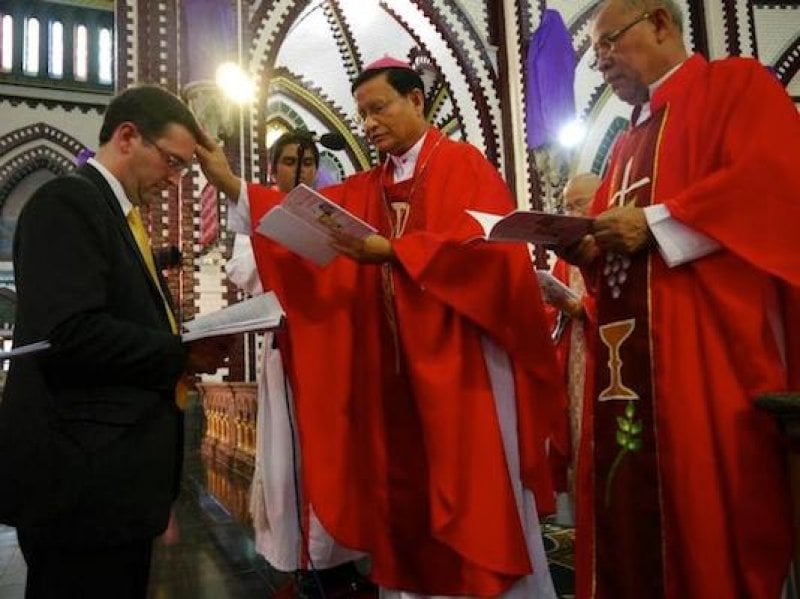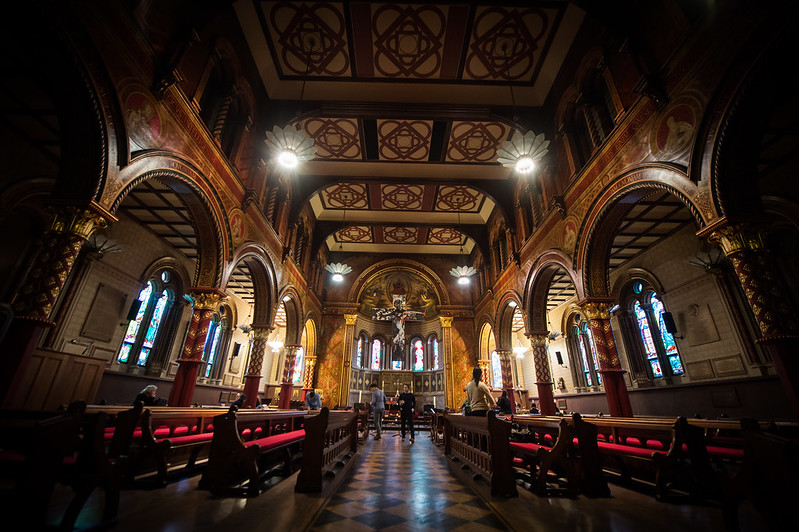The Stations of the Cross are technically described as “devotional practice”. The devotion is approved of by the Church but not part of official liturgical worship. It can be lay-led; it has various forms; you can write your own. This is a lot more freedom than we are used to in Catholic circles. It can be prayed all year round; most churches have the Stations permanently on view, but the devotion is particularly popular during Lent. There’s a lot of variation in the representative style of the Stations, from Victorian carvings and paintings or minimalist abstracts, to simple rosettes or numbers on the wall.
This year I volunteered to write a set of Stations for my church, because the Parish Liturgy Committee wanted to be able to offer the Stations twice a week through Lent, on Sunday afternoons and Friday evenings, so they needed volunteers. Our current church has a row of crosses welded to its back wall, so people tended to stay in the pews with their backs to the altar and just pivot slightly, but this year the liturgy committee was keen to hang a more representational set of pictures around the church interior, to allow people actually to walk between the different Stations. It’s not perfect, because our church’s layout means that there isn’t enough space between some of the Stations, but the effort is there.
I wanted to check what the irreducible core of “praying the Stations” was before I committed to mine, so I attended carefully for some of the early weeks. They nearly all used the St Alphonsus Liguori version, easily found in CTS pamphlet form, but I found it very formal and repetitious. Also, to my surprise, the emphasis was hugely on me, this miserable worm who caused all this suffering to my beloved Saviour, instead of being on the Saviour himself, which is what I had expected. I think it’s a question of date: the Stations have been around as a mini-pilgrimage since about the fifteenth century, created mainly by the Franciscans for people who could not go to the Holy Land and retrace Christ’s steps in the place where he lived. There must have been various different forms of words, because Saint Alphonsus is Counter-Reformation and rather later. He founded the Redemptorists (the only other Order who can give the Franciscans a run for their money on communicating the faith clearly and attractively), and wrote various much-loved prayer sequences, including his version of the Stations. But it is of its time, and carries various baggage, like a list of potential indulgences, which always makes me a bit queasy.
Obviously there are simpler versions of the Stations, which don’t revolve around a repeated and lengthy Act of Contrition. These are available in most Catholic prayerbooks, so you can pick and choose, and there was clearly a great deal of leeway. Even the Stations themselves can vary. Historically the number has varied quite a bit, and so have the actual events chosen to be represented. In modern times, Pope Saint John Paul II not only approved the introduction of a fifteenth Station, the Resurrection, he also encouraged the use of the Scriptural Way of the Cross (from 1991), where the Stations not actually from the Gospel text (six out of the original fourteen) are replaced with others. Pope Benedict also used this version.
I did not want to change any of the Stations, because I think part of the point of this devotion is that it is a folk retelling of the Passion, almost a dramatisation or even a screenplay. We have the official Gospel account read out to us on multiple occasions in Holy Week, but the Stations of the Cross are a warmer, more human retelling.
You can see this particularly clearly in the non-canonical Stations, which date all the way back to some of the oldest and shortest versions of the Stations that we know about. They are Jesus’ three falls, none of which is in the Gospels; Jesus’ encounter with Veronica; his meeting with his mother along the road (the Gospels have Mary at the foot of the cross but not present before); and Jesus’ body being given to Mary after he has been taken down from the cross (the Gospels say he is given to Nicodemus and Joseph of Arimathea). Purely narratively speaking, that’s not a good time to introduce two new characters. If you look at the Stations as a story told through a sequence of images, the value of the non-canonical Stations is very clear.
Jesus falls three times (Stations three, seven and nine) because he is the hero of this story and we are showing him doing something astonishingly painful and difficult. Story elements often use a multiple of three to give pattern and structure: three princesses, three sons, three bears, three pigs, three ordeals, three caskets, and so on and on; similarly we have three temptations in the desert, three denials by Peter, followed by three declarations of love. There are old versions of the Stations with even more than three. The falls are there to emphasise how heavy the cross is, how weary the Lord is, how he is dying on his feet. By the time we reach the third fall, we know, by all storytelling rules, that the end is near. There has never been any chance of rescue or escape.
The other crucial point of the non-canonical Stations for me is that they put the women back into the narrative. If you read the accounts carefully, it is clear that they must have been there throughout, but they are not mentioned until nearly at the very end (Matt 27.55; Mark 15.41, Luke 23.49), where the evangelists tell us (infuriatingly) that they have been there all the time. So Veronica (Station six), for me, is not just the female helper who corresponds to the arrival of a male helper, Simon of Cyrene in Station five, not just a pious myth to give a holy relic provenance, not just a crucial element to balance the story; she represents all these “many other women”.
Mary is there at Station four because that is where she must have been, accompanying her Son, desperately trying to stay as close as possible. The Stabat mater, the long hymn in triplets which is sometimes sung during the Stations (partly because it has more than enough verses, I think), is actually two centuries or so older than the Stations. It pictures Mary standing at the foot of the cross, as in the Gospel narrative, but it focuses on her reaction to the different stages of the Passion and can almost turn the Stations into a Marian devotion. I think this is going too far, but if Mary was standing at the foot of the cross, she was clearly there throughout.
The net result of these new all-canonical versions of the Stations (there’s another one in the Philippines) is to reduce the presence of women in the narrative. Just the encounter with the grieving women of Jerusalem is left in, and all the other encounters are man-to-man, except when Jesus entrusts Mary and John to each other when he is dying.
So I definitely wanted to stay with the traditional list of the Stations and my church had indeed tracked down a set of Victorian paintings with no surprises. I have always found the size of the Stations to be a problem, because you can’t actually see them very well. If you put them up on a screen, you could have them bigger, but then the congregation would not need to move from Station to Station. I think you have to give the title of each Station as you arrive at it, especially as the lighting may not be wonderful either (I discovered during my research that Saint Alphonsus was extremely short-sighted, losing his sight altogether at the end of his long life, so I understand better why he internalises so much of the Way of the Cross).
I had thought about using the pictures to talk about what is actually going on, but I decided that it was too hard to see the detail. So the first part of each Station is a simple reflection on what is happening at this point in the story, rather than who exactly is there. I would do this slightly differently with children, but our congregation for the Stations is nearly all older people, and they know the story, so you just need to focus on where we have reached. Once that was clear, what I wanted to do was to use the psalms as a way to pray the Stations. I dearly love the psalms because of my day job, and I don’t think we use them enough.
The psalms would have been as familiar to Jesus as our Mass-books, missals and hymn-books are to us; indeed, more so, because there was only the one version which stayed the same. They are the words he would have had in his head all along that dreadful journey. He would have known them by heart (this is why he quotes them so often). Sometimes I chose a psalm to contrast with what is going on, so when we have Jesus being condemned by Pilate in the first Station, we read part of Psalm 1, where the just man is celebrated. Similarly at the seventh Station (Jesus” second fall), we have Psalm 120, I lift up my eyes to the mountains […] May he never allow you to stumble. Most of the time, I used psalms with cries for help or expressions of faith, but I could have done several versions and not repeated myself, because the Psalms are such a rich resource. It was fascinating and moving to go through the psalter and choose verses which resonated for that particular Station.
We sang the first couple of verses of “When I survey the wondrous Cross” at the beginning, because I reckoned that would be familiar to everyone, a Taizé chant (Jesus, remember me) at the eleventh Station, when Jesus is hanging on the cross, and the rest of the first hymn at the end. Each Station began with the traditional, “We adore you, O Christ, and we praise you…” and we ended each one with an Our Father, a Hail Mary and a Glory be, because (again) that was familiar to everyone, and we followed it with a Lamb of God, plus a slightly longer prayer at the end.
It took about 45 minutes. I found some parts difficult to read (we shared out the reading), but it was a prayerful and moving experience, even for a Sunday afternoon. We’re going back to do it on a Friday evening; I shall be fascinated to see how much difference that will make. And I am longing for Easter.
Kate Keefe composes musical settings for the Mass and writes about the psalms. You can follow her on Facebook, Twitter and LinkedIn .



 Loading ...
Loading ...
What do you think?
You can post as a subscriber user ...
User comments (0)